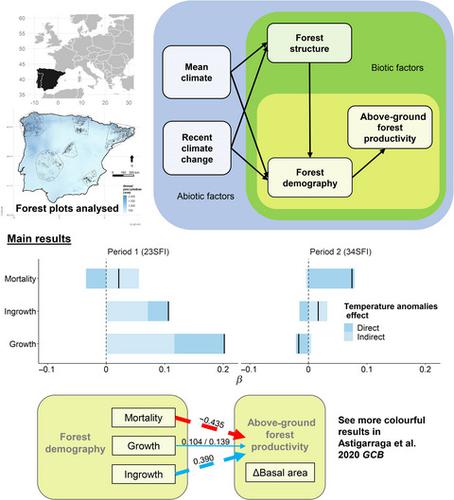当前位置:
X-MOL 学术
›
Glob. Change Biol.
›
论文详情
Our official English website, www.x-mol.net, welcomes your feedback! (Note: you will need to create a separate account there.)
Evidence of non-stationary relationships between climate and forest responses: Increased sensitivity to climate change in Iberian forests.
Global Change Biology ( IF 11.6 ) Pub Date : 2020-06-01 , DOI: 10.1111/gcb.15198 Julen Astigarraga 1 , Enrique Andivia 2 , Miguel A Zavala 1, 3 , Antonio Gazol 4 , Verónica Cruz-Alonso 1, 5 , Sergio M Vicente-Serrano 4 , Paloma Ruiz-Benito 1, 6
Global Change Biology ( IF 11.6 ) Pub Date : 2020-06-01 , DOI: 10.1111/gcb.15198 Julen Astigarraga 1 , Enrique Andivia 2 , Miguel A Zavala 1, 3 , Antonio Gazol 4 , Verónica Cruz-Alonso 1, 5 , Sergio M Vicente-Serrano 4 , Paloma Ruiz-Benito 1, 6
Affiliation

|
Climate and forest structure are considered major drivers of forest demography and productivity. However, recent evidence suggests that the relationships between climate and tree growth are generally non‐stationary (i.e. non‐time stable), and it remains uncertain whether the relationships between climate, forest structure, demography and productivity are stationary or are being altered by recent climatic and structural changes. Here we analysed three surveys from the Spanish Forest Inventory covering c . 30 years of information and we applied mixed and structural equation models to assess temporal trends in forest structure (stand density, basal area, tree size and tree size inequality), forest demography (ingrowth, growth and mortality) and above‐ground forest productivity. We also quantified whether the interactive effects of climate and forest structure on forest demography and above‐ground forest productivity were stationary over two consecutive time periods. Since the 1980s, density, basal area and tree size increased in Iberian forests, and tree size inequality decreased. In addition, we observed reductions in ingrowth and growth, and increases in mortality. Initial forest structure and water availability mainly modulated the temporal trends in forest structure and demography. The magnitude and direction of the interactive effects of climate and forest structure on forest demography changed over the two time periods analysed indicating non‐stationary relationships between climate, forest structure and demography. Above‐ground forest productivity increased due to a positive balance between ingrowth, growth and mortality. Despite increasing productivity over time, we observed an aggravation of the negative effects of climate change and increased competition on forest demography, reducing ingrowth and growth, and increasing mortality. Interestingly, our results suggest that the negative effects of climate change on forest demography could be ameliorated through forest management, which has profound implications for forest adaptation to climate change.
中文翻译:

气候与森林反应之间的非平稳关系的证据:伊比利亚森林对气候变化的敏感性增加。
气候和森林结构被认为是森林人口和生产力的主要驱动力。然而,最近的证据表明,气候与树木生长之间的关系通常是不稳定的(即非时间稳定的),并且仍不确定气候,森林结构,人口统计学和生产力之间的关系是否稳定或是否正在被近期改变。气候和结构变化。在这里,我们分析了三种调查,从西班牙森林库存回补Ç。30年的信息,我们应用了混合和结构方程模型来评估森林结构(林分密度,基础面积,树木大小和树木大小不平等),森林人口统计(向内生长,生长和死亡)和地上森林生产力的时间趋势。我们还量化了气候和森林结构对森林人口统计学和地上森林生产力的互动影响在两个连续时间段内是否稳定。自1980年代以来,伊比利亚森林的密度,基础面积和树木尺寸增加,树木尺寸不平等性降低。此外,我们观察到向内生长和生长的减少,以及死亡率的增加。最初的森林结构和水的供应量主要调节了森林结构和人口统计学的时间趋势。在分析的两个时间段内,气候与森林结构对森林人口统计学的交互作用的大小和方向发生了变化,表明气候,森林结构与人口统计学之间的非平稳关系。由于向内生长,生长和死亡之间的正平衡,地上森林生产力提高了。尽管随着时间的推移生产力不断提高,但我们观察到气候变化的负面影响加剧了,森林人口竞争加剧,减少了向内生长和生长,并增加了死亡率。有趣的是,我们的结果表明,通过森林经营可以减轻气候变化对森林人口的负面影响,这对森林适应气候变化具有深远的影响。
更新日期:2020-06-01
中文翻译:

气候与森林反应之间的非平稳关系的证据:伊比利亚森林对气候变化的敏感性增加。
气候和森林结构被认为是森林人口和生产力的主要驱动力。然而,最近的证据表明,气候与树木生长之间的关系通常是不稳定的(即非时间稳定的),并且仍不确定气候,森林结构,人口统计学和生产力之间的关系是否稳定或是否正在被近期改变。气候和结构变化。在这里,我们分析了三种调查,从西班牙森林库存回补Ç。30年的信息,我们应用了混合和结构方程模型来评估森林结构(林分密度,基础面积,树木大小和树木大小不平等),森林人口统计(向内生长,生长和死亡)和地上森林生产力的时间趋势。我们还量化了气候和森林结构对森林人口统计学和地上森林生产力的互动影响在两个连续时间段内是否稳定。自1980年代以来,伊比利亚森林的密度,基础面积和树木尺寸增加,树木尺寸不平等性降低。此外,我们观察到向内生长和生长的减少,以及死亡率的增加。最初的森林结构和水的供应量主要调节了森林结构和人口统计学的时间趋势。在分析的两个时间段内,气候与森林结构对森林人口统计学的交互作用的大小和方向发生了变化,表明气候,森林结构与人口统计学之间的非平稳关系。由于向内生长,生长和死亡之间的正平衡,地上森林生产力提高了。尽管随着时间的推移生产力不断提高,但我们观察到气候变化的负面影响加剧了,森林人口竞争加剧,减少了向内生长和生长,并增加了死亡率。有趣的是,我们的结果表明,通过森林经营可以减轻气候变化对森林人口的负面影响,这对森林适应气候变化具有深远的影响。



























 京公网安备 11010802027423号
京公网安备 11010802027423号